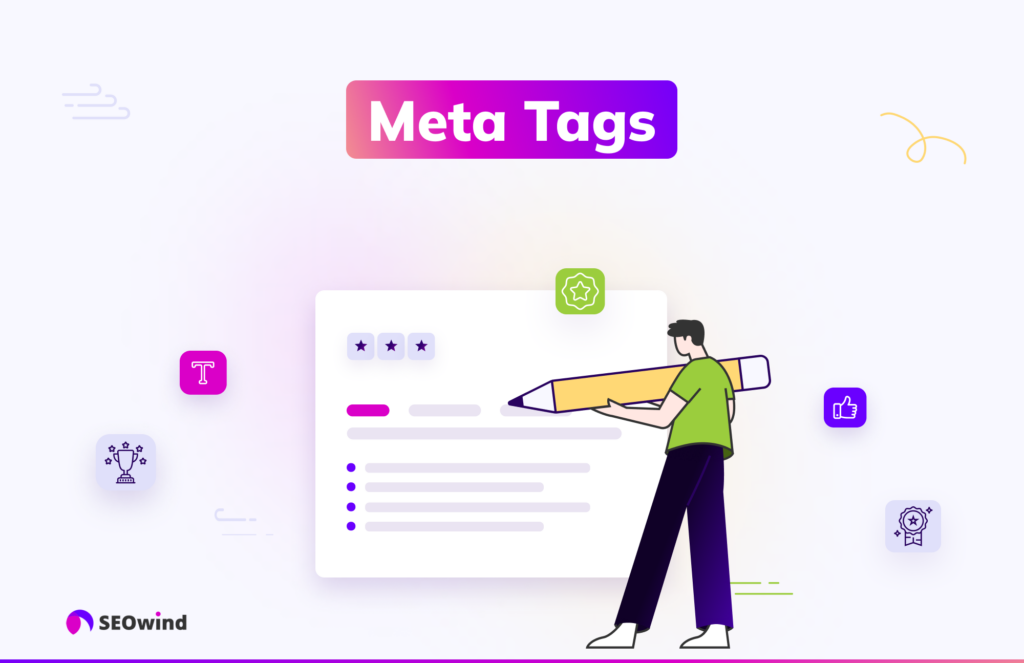Uncover the secrets of HTML meta tags! Learn how to optimize your SEO strategy with this step-by-step guide. #SEOhacks

Image courtesy of via DALL-E 3
Table of Contents
Welcome, young creators! Today, we are going to dive into the exciting world of HTML meta tags. But what are HTML meta tags, you may ask? Well, they are like secret codes that help search engines, such as Google, find and understand your website better. Think of it as giving search engines a map to your website so they can show it to the right people. This step-by-step guide will make adding meta tags to your website feel like a fun project!
Now, let’s roll up our sleeves and get ready to enhance our websites with some cool HTML meta tags for better SEO!
What are HTML Meta Tags?
HTML meta tags are like special labels for web pages. They help search engines understand what a page is about so they can show it to the right people. Think of meta tags as secret messages that tell search engines important things about a webpage.
Definition of Meta Tags
Meta tags are snippets of text in the HTML code of a webpage that provide information about the page itself. They are not visible on the actual page but are crucial for search engines like Google to know what the page is all about. It’s like giving search engines a little hint about the content.
Why Meta Tags Matter
Meta tags are important because they help search engines categorize and understand the content of a webpage. When someone searches for something on the internet, search engines use meta tags to determine which pages are most relevant to the search query. This way, a webpage with well-crafted meta tags is more likely to be shown to people who are looking for that specific information.
Common Types of Meta Tags
Meta tags play a crucial role in helping search engines understand and rank your web page. Let’s take a look at some common types of meta tags that can make a big difference in your website’s visibility.
Title Tag
The title tag is like the headline of your web page. It tells search engines and people what your page is about. It’s important to make your title short, relevant, and include keywords related to your content. This helps search engines show your page to the right audience.
Description Tag
The description tag gives a brief summary of what your web page is about. It’s like a sneak peek that appears below the title in search engine results. A clear and enticing description can encourage people to click on your link. Make sure it accurately describes your content to attract the right visitors.
Keywords Tag
The keywords tag is a list of words or phrases that are relevant to the content on your page. These keywords help search engines understand the main topics of your website. Choose your keywords wisely and use terms that people might use when searching for content like yours.
How to Add Meta Tags to a Web Page
Adding meta tags to a web page is like giving directions to search engines so they can help people find your page. Here’s a simple guide to help you add meta tags to your own web page!

Image courtesy of seowind.io via Google Images
Step 1: Opening the HTML File
First, open the HTML file of your web page using a simple text editor. This is where you’ll be able to edit your page and add the meta tags.
Step 2: Inserting Meta Tags
Now, it’s time to insert the meta tags into your HTML file. Find the <head> section of your HTML code and insert the meta tags there. Remember to include the title, description, and keywords meta tags.
Step 3: Saving and Viewing Changes
After inserting the meta tags, save the HTML file. Then, open the file in a web browser to see if the meta tags are showing up correctly. This step will help you ensure that search engines can read the meta tags properly.
Best Practices for Using Meta Tags
When adding meta tags to your website, it’s essential to keep the title tags short and sweet. Search engines like Google prefer concise titles that accurately reflect the content of the page. By using relevant keywords in your title tag and keeping it under 60 characters, you can improve the chances of your webpage showing up in search results.
Write Clear Descriptions
Another important best practice for using meta tags is to write clear and useful descriptions for each page. The description tag gives a brief summary of what the page is about, so make sure it accurately describes the content. Aim for around 150-160 characters to ensure that it displays correctly in search results and entices users to click on your webpage.
Choose Relevant Keywords
When selecting keywords for the keywords tag, it’s crucial to choose ones that are relevant to the content of your webpage. Think about what words or phrases users might type into a search engine to find your page. Avoid using irrelevant keywords just to attract more traffic, as this can have a negative impact on your SEO. Focus on quality over quantity when it comes to keyword selection.
Tracking the Impact of Meta Tags
Once you’ve added meta tags to your web page, it’s important to track their impact to see if they’re helping your site appear higher in search results. Here’s how you can do it:

Image courtesy of medium.com via Google Images
Using SEO Tools
There are simple SEO tools available that can help you analyze how well your website is performing. These tools can show you important information like how many people are visiting your site, where they are coming from, and what keywords they used to find your site. By using these tools, you can track the effectiveness of your meta tags and make adjustments as needed to improve your SEO.
Checking Search Rankings
Another way to track the impact of your meta tags is by checking your search rankings over time. You can do this by searching for specific keywords related to your website and seeing where your site appears in the search results. By regularly checking your search rankings, you can see if your meta tags are helping your site climb higher in the search results, bringing in more visitors.
Fun Project: Adding Meta Tags to a Personal Web Page
Are you ready for a fun project that will make your website easier to find on search engines like Google? Adding meta tags to your personal web page can help improve its visibility and attract more visitors. Let’s dive into how you can add these special pieces of code to your webpage!
Setting Up a Simple Web Page
First, let’s set up a basic webpage where we can add our meta tags. You can create a simple HTML template by copying the following code into a text editor:
<!DOCTYPE html>
<html lang="en">
<head>
<title>My Personal Web Page</title>
</head>
<body>
<h1>Welcome to My Web Page!</h1>
<p>This is where you can learn all about me.</p>
</body>
</html>
Save this file with a .html extension, like “mypage.html”. This will be the webpage you’ll be adding meta tags to!
Adding Meta Tags
Now, it’s time to insert meta tags into your webpage to make it more SEO-friendly. Follow these steps:
- Title Tag: In the <head> section of your HTML file, add the following line: <title>Your Page Title</title>. Replace “Your Page Title” with a catchy title that describes your page.
- Description Tag: Directly below the title tag, insert: <meta name=”description” content=”A brief description of your page”>. Write a short summary of what your webpage is about.
- Keywords Tag: Add a keywords tag by including: <meta name=”keywords” content=”keyword1, keyword2, keyword3″>. List relevant keywords related to your webpage content separated by commas.
Ensure to save your changes after adding these meta tags to your HTML file.
Showing Off Your Page
Once you’ve added your meta tags, it’s time to share your improved webpage with friends and family! Simply open your HTML file in a web browser to view your page with the meta tags included. You can also upload your HTML file to a free web hosting service to make it accessible online.
By following these simple steps, you’ve successfully enhanced your personal web page with meta tags, making it more search engine friendly. Give it a try and watch your webpage attract more visitors!
Conclusion
HTML meta tags are like secret messages that help search engines like Google understand what a webpage is all about. By using meta tags correctly, website owners can make their pages easier to find by the right people. Remember, meta tags are like a map that guides search engines to the treasure trove of information on a webpage.

Image courtesy of seowind.io via Google Images
Meta tags matter a lot because they communicate crucial information such as the title, description, and keywords related to the content of a webpage. This information helps search engines match the right pages to people’s search queries. So, using meta tags smartly can boost a webpage’s chances of showing up higher in search results.
When adding meta tags to a webpage, it’s essential to keep titles short and relevant, write clear and informative descriptions, and choose keywords that accurately represent the content. These best practices ensure that search engines can easily understand and categorize the webpage’s content, improving its chances of being seen by the right audience.
Tracking the impact of meta tags is important to see if they are actually helping a webpage rank better in search results. By using simple SEO tools and checking search rankings regularly, website owners can monitor the performance of their meta tags and make adjustments to improve their SEO strategy.
So, for a fun project, try adding meta tags to your personal webpage and see how it can make a difference in how easy it is for others to discover your content. Remember, meta tags are a powerful tool in the world of SEO, helping to connect web pages with the people who are searching for them.
With a little practice and creativity, anyone can master the art of using meta tags to enhance the visibility and accessibility of their web pages. Happy tagging!
Want to turn these SEO insights into real results? Seorocket is an all-in-one AI SEO solution that uses the power of AI to analyze your competition and craft high-ranking content.
Seorocket offers a suite of powerful tools, including a Keyword Researcher to find the most profitable keywords, an AI Writer to generate unique and Google-friendly content, and an Automatic Publisher to schedule and publish your content directly to your website. Plus, you’ll get real-time performance tracking so you can see exactly what’s working and make adjustments as needed.
Stop just reading about SEO – take action with Seorocket and skyrocket your search rankings today. Sign up for a free trial and see the difference Seorocket can make for your website!
Frequently Asked Questions (FAQs)
Here are some common questions that kids might have about meta tags and SEO:
Are Meta Tags Hard to Add?
Meta tags are actually not hard to add once you understand how they work. They are like little notes that you can attach to your website to help search engines understand what your page is about. With a bit of practice, you can easily add meta tags to your web pages!
Do All Web Pages Need Meta Tags?
While not all web pages absolutely need meta tags, adding them can significantly help your website get noticed by search engines like Google. Meta tags act as a way to tell search engines what your page is about, which can lead to better visibility in search results. So, it’s a good idea to include them whenever you can.
Can Meta Tags be Changed Later?
Yes, meta tags can be changed later on if needed. If you want to update the information you’ve provided in your meta tags or if you realize that specific keywords are not bringing the desired results, you can always go back and make changes. It’s important to review and update your meta tags from time to time to keep your web page optimized for search engines.







